The U.S. House of Representatives will vote on March 26 in an attempt to override President Donald Trump’s veto of a resolution that would stop him from building the southern border wall with his national emergency declaration.
There is only one problem. The House clearly lacks the votes to do so. With 432 currently filled seats — three are vacant at the moment — it will take 289 votes in order to overturn Trump’s veto.
That is 44 more votes than the 245 the House mustered to overturn the President’s declaration in the first place on Feb. 26. And House Minority Whip Steve Scalise (R-La.) already declared any veto override dead on arrival in February, saying, “there will be nowhere near the votes to override a veto.”
In the Senate, the vote to overturn the national emergency only scored 59 votes, eight short of the 67 needed to overcome the veto.
So, it merely amounts to more posturing on the issue by members of Congress, nominally asserting opposition to Trump’s wall construction without actually doing anything to stop it.
As far as Trump’s power under the law to enact the emergency and reprogram $5.7 billion of uncommitted military construction funds, that is clearly allowed for under 10 U.S. Code § 2808(a), a limited grant of authority which states, “In the event of a declaration of war or the declaration by the President of a national emergency in accordance with the National Emergencies Act (50 U.S.C. 1601 et seq.) that requires use of the armed forces, the Secretary of Defense, without regard to any other provision of law, may undertake military construction projects, and may authorize the Secretaries of the military departments to undertake military construction projects, not otherwise authorized by law that are necessary to support such use of the armed forces. Such projects may be undertaken only within the total amount of funds that have been appropriated for military construction, including funds appropriated for family housing, that have not been obligated.”
That particular provision of law comes from the 1982 Military Construction Codification Act, which expanded some of the authorities from the 1976 National Emergencies Act. Both were enacted by Congress and signed into law.
Which is how it is supposed to work. Congress passes a law saying the President can do certain things under specific terms and conditions, and the President checks those boxes when he invokes that law.
For the $5.7 billion, the White House identified “[a]bout $601 million from the Treasury Forfeiture Fund… Up to $2.5 billion under the Department of Defense funds transferred for Support for Counterdrug Activities (Title 10 United States Code, section 284)… [and u]p to $3.6 billion reallocated from Department of Defense military construction projects under the President’s declaration of a national emergency (Title 10 United States Code, section 2808)…”
That would come atop the $1.6 billion that Congress passed in 2018 for replacing existing fencing with new steel barriers and the $1.375 billion in 2019 for more steel barriers that was approved after the partial government shutdown earlier this year.
With drugs, gangs and human traffickers continuing to press on the border it is easy to make a case for sustaining the President’s veto of legislation that would stop him from securing the border. Now it is up to enough Republicans in Congress to stand with Trump and thwart the House’s last, desperate attempt to stop him.
Robert Romano is the Vice President of Public Policy at Americans for Limited Government.








